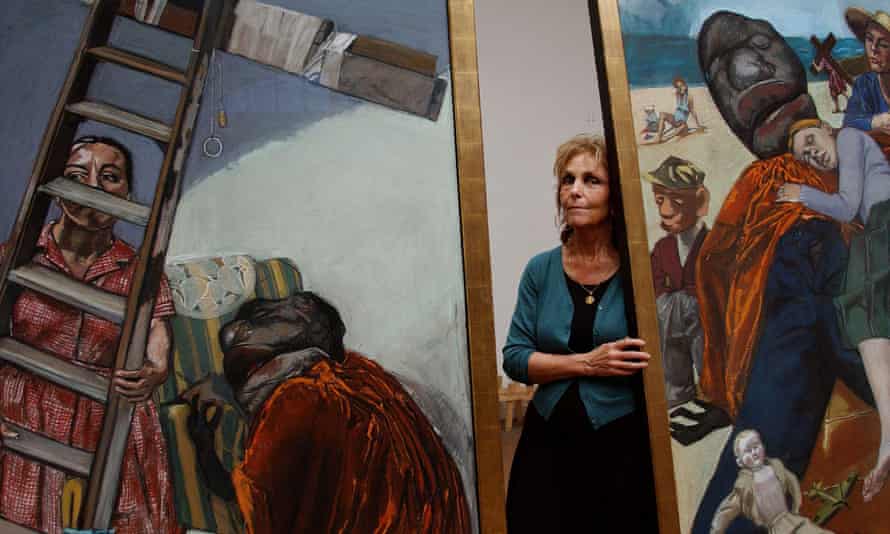 |
| Most of Paula Rego’s late and best work was done in pastel, such as this piece, Love, 1995. |
‘She could make anything part of a story’ – what Paula Rego chose to paint and why
However volatile her subject matter, her art never tells you what to feel, writes the Guardian’s art critic – although she could indulge in a kind of knockabout buffoonery
Adrian Searle
Thu 9 June 2022
When Paula Rego showed at the Serralves Museum in Porto in 2004, such was her fame in her native Portugal that the museum was kept open all night, and she was frequently accosted on the streets of the city with something like adulation. Fame never really affected her, and while some artists coast through their later careers, Rego continued to surprise and shock right to the end. Her work was both deeply personal and spoke of larger issues.
She told the truth and she made things up: Rego was a storyteller, both in her art and in conversation. All the people in her paintings and pastels come with backstories, alibis and dramas, and although full of clues to these histories – which the artist somehow needed in the invention of her images – her paintings are primarily pictorial dramas. In them, a lot is left unsaid, which makes her images all the more powerful and disturbing. Withholding is part of her game, but she never locked the viewer out. In interview and conversation, she could be alarmingly, refreshingly candid.
While personal passions and the illness of her husband, the painter Victor Willing, provided the subject of many works, so too did the regime of Portugal’s dictator António de Oliveira Salazar, and its consequences in a small country riven by class, ignorance, Catholicism and an oppressive political climate, not least in Portugal’s appalling and ultimately fated colonialist interventions in Angola and Mozambique. Repression and silence are part of Rego’s vocabulary. As her fellow Portuguese artist Julião Sarmento remarked, sourly: “Ours was not an elegant fascism.”
Rego’s work had an unremitting psychological and political charge and atmosphere, whether she titled a 1961 mixed media work When We Had a House in the Country We’d Throw Marvellous Parties and Then We’d Go Out and Shoot Negroes, or in a seemingly simple picture of a pregnant young woman seated in an armchair, her bare feet crossed. Like Christ’s, you might think. What is really disquieting here are her hands hidden under her dress, protectively clasped over her belly, and her upturned head, eyes darting to one side with something like fear at something we can’t see. Rego could do a lot with very little.

What went on behind closed doors was always a fascination for the artist, and gave her an opportunity to create vivid and disturbing Buñuel-like domestic scenes, frequently drawing on her own upbringing and family stories. She could be funny, too, in a sardonic way that could be paralleled in the fictions of her countryman José Saramago. The rights of women, and their place in the home as well as larger society, provided the focus of many paintings and prints, whether played-out in images of children’s games or murderous domestic strife between a monkey and a bear. She could make anything part of a story: a girl polishing a man’s riding boot, a chicken ready to be stuffed (with a rotting pear among the cabbages and leeks on the board beside it), two girls playing with a dog (an ominous claw-hammer on the ground nearby), a young woman being fitted for a gorgeous dress.
In her harrowing 1998-9 pastels and etchings, titled The Abortion Series, women are seen alone and abject, demoralised but somehow resilient, even if they inhabit a situation in which they are barely in possession of their own bodies. Another series of drawings and etchings, made 10 years later, depict the horrors of female genital mutilation. In all these images, everyday details make them especially redolent: a woman’s trainer, precisely described, plastic buckets and bowls, and collapsing garden chairs as makeshift gynaecological stirrups.
Rego’s etchings have been compared to Goya’s. She shared his interest in the folkloric as well as his anti-clericism and his rails against provincial inwardness. She also developed a kind of straightforwardness in her technique – not exactly a realism, but certainly a detachment from overt expressionism. Her art never tells you what to feel, and is all the better for that, however volatile her subject matter. She could, however, indulge in a kind of knockabout buffoonery. There’s a certain theatricality about her art, not least in some of the works she showed in the main exhibition of this year’s Venice Biennale. Often using props and mannequins as well as life models in her studio to construct her paintings, they sometimes migrated both into the paintings themselves, and as real sculptural elements.
The current biennale exhibition is the first to be dominated by women, and Rego’s works here, and in particular her 2019 Seven Deadly Sins, with its dramatically lit dolls and sculptural figures, is an alarming, vertiginous tableau, surrounded by a series of paintings begun in 1994 of women behaving like dogs, sleeping on the floor beside bowls of food, baying and with their legs in the air. Although she used a model to make these, she said that the women were really herself. Difficult psychosexual dramas they may be, they were also the work of an artist who refused to lie down. Her art stands up with the best.
THE GUARDIAN



No comments:
Post a Comment